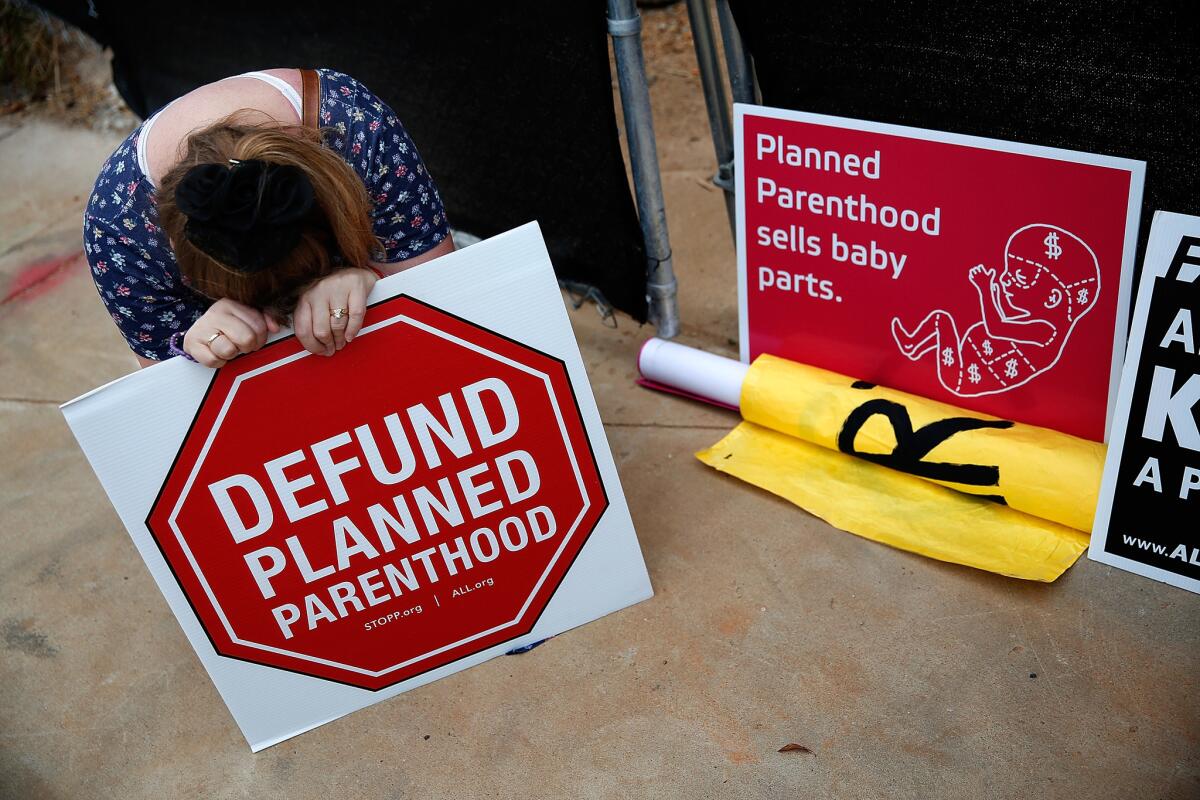The cost of defunding Planned Parenthood: Less healthcare for 650,000 women

An antiabortion protester demonstrates in front of a proposed Planned Parenthood location in Washington on Sept. 21.
Earlier Tuesday, we reported the Congressional Budget Office’s estimate of the cost of blocking federal funding for Planned Parenthood for one year, as the GOP-controlled House of Representatives voted last week to do.
Later in the day, the CBO issued an analysis of a House measure that would permanently eliminate federal funding for the organization. Its conclusion is that permanent defunding would cost the government tens of millions of dollars and, like the one-year cutoff, deprive as many as 650,000 women at least partially of access to healthcare.
The House took its vote last week in the grip of an obsession fueled by deceptive videos. The measure hasn’t yet been taken up by the Senate and would certainly earn a presidential veto.
The CBO found that the one-year defunding would produce about $235 million in federal savings, barely a rounding error in the federal budget, but that the real costs would be borne by low-income and rural women.
In human terms, the CBO’s bottom line is that as many as 650,000 women, chiefly in low-income neighborhoods or communities “without access to other health care clinics,” would lose at least some access to care. The measure would hamper Planned Parenthood’s ability to provide low-income women with “contraceptive education and counseling; pregnancy diagnosis and counseling; cervical and breast cancer screening; and education, testing, and referral services associated with sexually transmitted diseases.” Several thousand unwanted pregnancies and births would occur.
Permanent defunding, the CBO says, would increase federal spending by $130 million over 10 years. Most of the increase would be the result of thousands of unwanted births needing to be covered by Medicaid, as well as coverage of the childrens’ healthcare.
The bill approved by the House Friday would cut off Planned Parenthood funding for a year unless its affiliates and clinics cease performing abortions. The tally was mostly on party lines, with two Democrats crossing over to cut Planned Parenthood funding and three Republicans opposing the bill. One Republican, Steve King of Iowa, voted “present” as a protest; he wants funding cut off permanently. Put it all together, and you get a picture of the House of Representatives as a threat to public health.
Here are the details. The CBO reports that Planned Parenthood receives about $450 million a year in federal funding, accounting for about one-third of its annual budget. Most of the funding comes through Medicaid, the federal-state program for low-income people; $60 million comes from Title X, the Nixon-era family-planning program for low-income families.
If Planned Parenthood can’t replace this funding from other sources, some Medicaid beneficiaries wouldn’t obtain services at all. The CBO guesses -- it says it doesn’t have the data to know for sure -- that between 5% and 25% of Planned Parenthood’s 2.6 million clients, or up to 650,000 women, would lose some or all of their access to care.
Some of the savings from the funding cutoff would be reduced by the cost of covering the births that would result and caring for the children as they grow up--the permanent cutoff would increase the number of unwanted births and therefore those costs. Already, about 45% of all births in the U.S. are covered by Medicaid.The Guttmacher Institute, an authoritative source on reproductive health, says that figure includes 68% of the 1.5 million unplanned births per year. The institute based its estimate on 2010 statistics; family planning, including the services provided by Planned Parenthood, saved the nation about $15.5 billion that year, the institute estimated.
Republicans leading the charge against Planned Parenthood have been consistently cavalier about the lost access to healthcare that would result from a funding cutoff.
Among the party’s presidential candidates, former Florida Gov. Jeb Bush has worn his 2001 cutoff of $300,000 state funds for the organization like a badge of honor; the money, which had covered family planning and healthcare services, has never been restored. Last month, appearing at a conference of evangelical Christians, Bush cited the federal funding for Planned Parenthood, saying, “I’m not sure we need half a billion dollars for women’s health issues.” His campaign later said he “misspoke.”
Meanwhile, Louisiana Gov. Bobby Jindal has been trying to shut down his state’s two Planned Parenthood clinics, despite clear evidence that adequate alternative healthcare sources don’t exist for the 5,200 women served by the offices.
Then there’s Carly Fiorina. The former chair and CEO of Hewlett-Packard has staked out a position on the extreme edge of Planned Parenthood attackers and promotes a manifestly fabricated version of the anti-Planned Parenthood videos. On Sunday, she told Chris Wallace of Fox News that she supported providing all those family planning and healthcare services to women, but chiefly if they were supplied by “a women’s health center ... that would provide all those same services and also provide women an alternative to abortion.”
Of course, Planned Parenthood does provide women with alternatives to abortion -- that’s what most of those family planning services are. Fiorina not only advocates cutting off funding for the organization, but is in favor of shutting down the government to do so.
Keep up to date with the Economy Hub. Follow @hiltzikm on Twitter, see our Facebook page, or email [email protected]







